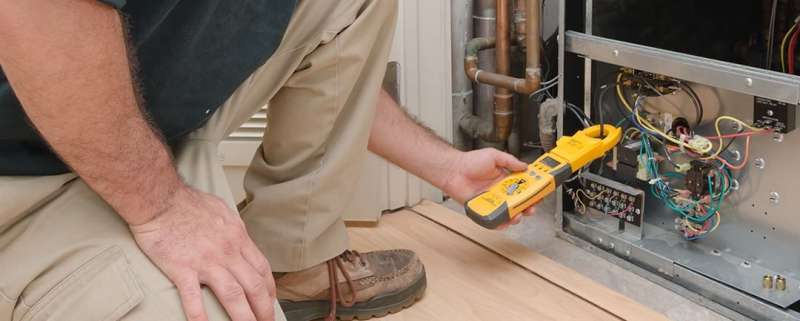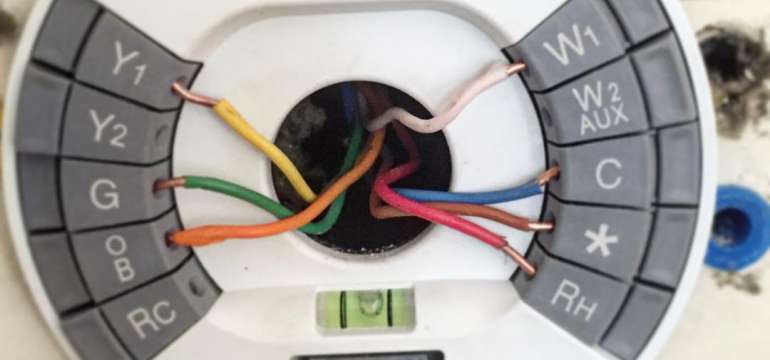Having no power to your thermostat is not only frustrating, it also prevents you from keeping your home the temperature that’s most comfortable for you. There are several possible reasons why your thermostat may have no power.
Although diagnosing the problem may seem like a complicated issue, if you follow the steps below, you’ll be able to pinpoint the issue in to time at all. By doing it yourself instead of calling a professional, you’ll also save yourself a little cash, too.
My thermostat has no power. What should I do?
When your thermostat isn’t getting any power, the first thing that you’ll want to do is check whether or not the thermostat is actually turned on. Although this may sound a little goofy, you’d probably be a little surprised to find out how many people actually bump into their thermostats when passing by and accidentally turn them off.
If you’re unfamiliar with how to turn your thermostat on, you’ll want to read the owner’s manual. Once you realize that your thermostat is in fact on, make sure you turn the temperature higher than the current room temperature if you’re heating up your home or lower if you’re cooling it.
Check your home’s power supply

If you know your thermostat is turned on, then it’s time to investigate a little further. First, inspect your home’s circuit breaker. The reason is because your home’s electrical system is what runs the thermostat. Now, if the circuit that’s powering your thermostat trips, then you’ll have a loss of power. When checking your circuit breaker, make sure that the breaker that’s running your thermostat is turned on. If a breaker did get tripped, reset it.
On the other hand, if this didn’t solve your problem, go downstairs to your sump pump, if you have one, and see if the outlet that your sump pump is plugged into has been tripped. If so, flip the switch on the outlet and see if the display on your thermostat is back on. This is a common problem for many homeowners. If you don’t have a sump pump, then you’ll still want to see if the outlet that your HVAC equipment is plugged into has been tripped, and just like mentioned above, simply flip the switch to turn it back on.
Replace those old batteries

Bad batteries may also be a contributing factor when your thermostat is getting no power. The controls, in addition to the display on most thermostats, are run by batteries. If you haven’t changed them in a while, it probably means they need to be replaced. The batteries are usually located on the inside of the thermostat, so you’ll need to start by removing the cover. If you need additional information on this, you’ll want to refer to the reference guide.
Low voltage HVAC equipment

On the other hand, the display and the controls on some thermostats are not powered by batteries. In fact, many thermostats are powered by the 24 volts from the transformer. This transformer is located inside your HVAC equipment and is what is referred to power stealing technology. However, if your HVAC equipment has low voltage, it can cause the screen on your thermostat to go completely blank.
When you find yourself in this position, again check your fuse box to make sure you didn’t trip a breaker. If you find that you did trip a breaker, simply reset it. However, if the breaker trips a second time, you might want to contact a professional unless you have experience in this area.
Another reason why there’s no power to the thermostat could be due to a bad transformer or even a faulty wire running from the thermostat to the transformer. Nails, pests like mice and rats, and corrosion can all be a contributing factor. If you find that your wires are damaged, or your transformer is bad, you’ll need to hire professional help unless you have the knowledge to complete the job yourself.
A bad fuse may be the culprit

If you see that the switch is turned to the on position, and you’re still not getting power, then it’s time to inspect the thermostat’s fuse. You’ll want to start by removing the cover and looking for the fuse. Different models put them in different areas, but if you don’t know what a fuse looks like, it’s a small glass tube with metal on the ends.
When inspecting the fuse, look for the filament running through its length. If you notice that the filament is broken, then you know that the fuse will need to be replaced. You can purchase new fuses at most home improvement stores for a very reasonable price.
Furthermore, you need to know that this may have happened due to other circuit components. For instance, a bad relay coil or a direct short between a 24 v AC wire and Common or Ground can cause a lot of current to flow through the fuses. The fuses are just not made to handle that much amperage. The fuse will literally pop out when this happens.
If you want to check your fuse and other circuit components, simply inspect it or hook it up to a multimeter (Testing for a blown fuse). However, if you don’t have any experience with electrical components, you will need to call a professional to have a look.
Clean your thermostat
Another reason your thermostat might have no power could be due to being dirty. If the device hasn’t been cleaned in a while, that can cause several issues, including the inability to turn on. Things like nicotine, dirt, dust, and other filth can build up on the inside and will need to be cleaned on a regular basis so the thermostat will properly function.
To clean your thermostat, simply unsnap or unclip the outer cover and then use either a can of compressed air or an old rag to blow or wipe away the grime. Once you have cleaned the inside of the thermostat, you can then put the cover back on.
Check for incorrect electrical wiring
Is your thermostat still not getting power? Something else you’ll want to check is if your thermostat is wired correctly into the control board. On your control board, you’ll find several terminals into which your thermostat will need to be correctly wired.

On your circuit board, you’ll find an R terminal, a C terminal, a G terminal, a Y terminal, and a W terminal. There aren’t any standards for wire colors. Here are common uses and preferred colors for these wires:
❖ R terminal will use the red wire. (24 v AC from the control board)
Rc: Power for cooling
Rh: Power for heating
❖ C terminal will use the blue or black wire (Common wire, enables the continuous flow of 24 v AC from the Red wire.)
❖ G terminal will use the green wire. (Fan)
❖ Y terminal will use the yellow wire. (Air conditioner)
❖ W terminal will use the white wire. (Heat)
For example, if you want to turn the fan on, power flows from the red (R) wire to the green (G) wire. All these wires will need to be plugged into the corresponding terminals on the inside of your thermostat.
While you’re inspecting the wires, you’ll also want to make sure that none of the wires are damaged, corroded, or have been chewed through by a pest.
In addition to this, you’ll also want to make sure the area is clean and nothing is wet. Thermostats that are located in the basement of a home can be damaged by leaky ceilings and walls.
Easy to use checklist
Like mentioned already, when you have no power to your thermostat, there are several reasons why this could be happening. For your convenience, use this simple checklist:
✔ Inspect the breaker box to see if a breaker has been tripped. If so, reset it. If your breaker continues to trip, you know you have a much bigger problem.
✔ Clean your thermostat. You can use a can of compressed air or a rag. Simply wipe or blow away the dirt, grime, and if someone in your household smokes, the nicotine residue.
✔ If your thermostat is powered by batteries, check them to see if they’re still good. If they’re dead, replace them. Batteries generally need to be replaced, on average every 6 to 8 months.
✔ If your thermostat is not powered by batteries, you’ll want to check if your HVAC equipment, including the transformer, is working properly.
✔ Check if the fuse is bad. To see if the fuse needs replacing, you can visually inspect it or use a multimeter to test it.
✔ Inspect the wiring. Make sure that your thermostat is correctly wired into the circuit board, and that none of the wires have been corroded, are damaged, or have been chewed by pests.
If, after checking all of the items on this checklist, your thermostat still has no power, you’ll probably want to call a professional to look at the problem.
- What to Do if Your House Smells Like Gas but There’s No Leak - February 6, 2023
- Why Is There a Burning Smell Coming From My Vents? - August 16, 2022
- How to Remove the Musty Smell From Your Air Conditioner - August 16, 2022

Brenda G
Thursday 23rd of September 2021
My Honeywell thermostat isn’t working on Heat but working on AC. I raised the temperature as high as it would go and still no heat. The Heat On sign is on but blower doesn’t come on.
JAH
Tuesday 4th of July 2023
@Brenda G, Replace the thermostat. I had one that worked for heat but not for AC even though it had 24 volt power to the thermostat.
steven kallstrom
Thursday 5th of November 2020
I have a lennox G61MPV, which is giving me problems. I can't keep it going. The codes read 1 solid green and 5 flashing red. But when I kept an eye on it the red would go from 5-4-5-4 and the green would be solid. I get so much advice, but nothing that tells me where to go 1st. Can anyone help me.
David K
Monday 24th of August 2020
Thank you for the pointers! My AC was out randomly, which I didn't realize until the temperature had climbed 7 degrees. I was at a loss, but ultimately checking on the switch in the AC's small power box got it back up and running. Saved me a call, a bill, and a wait!